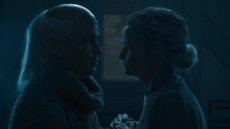Create a free profile to get unlimited access to exclusive videos, sweepstakes, and more!
Simon Kinberg on Dark Phoenix, the Twilight Zone and why sci-fi clichés don't exist

When it comes to alternate dimensions and reimaginings of familiar characters in unfamiliar storylines; Simon Kinberg is a low-key expert.
In addition to his connections to the X-Men and Twilight Zone franchises, Kinberg wrote the screenplay for the xXx movie without Vin Diesel, adapted the screenplay for Abraham Lincoln: Vampire Hunter, and put words in Robert Downey Jr.'s mouth in the 2009 steampunky version of Sherlock Holmes. Now, he's taking a new step in his career: the newest film in the X-Men franchise — Dark Phoenix, out this weekend — has been touted as Kinberg's directorial debut, but technically, that landmark goes to the season finale of the Jordan Peele's new version of The Twilight Zone. Kinberg directed "Blurryman" and found an easy transition in an episode that finds a writer trapped inside an episode of The Twilight Zone.
As the finale of the new version of the famous sci-fi anthology series, "Blurryman" has its nostalgic Twilight Zone cake and eats it, too. The ending of the episode features an alternate universe version of original Twilight Zone host Rod Serling literally becoming part of the plot of the episode. For Kinberg's dimension-hopping resume, the bizarro Rod Serling in "Blurryman" could be seen as par for his particular course. After all, the new Dark Phoenix film is also his second stab at adapting a specific X-Men comic book storyline. So, what makes all these old beloved tropes so enduring?
"I think concepts are never played out," Kinberg tells SYFY WIRE. "It's just about the execution of them. Think about it: Just when people think time travel is cheesy, Avengers: Endgame comes along and does it differently and emotionally. That's what's so great about science fiction. How many robots and apocalypses and aliens have we seen? The best ones rise above the rest, and endure."
In "Blurryman," the rebooted Twilight Zone revisits post-apocalyptic imagery made famous by the original 1959 episode "Time Enough At Last"; that immortal episode in which the last man on Earth (Burgess Meredith) can't indulge in reading all his books because his glasses break in the final scene. "Blurryman" pays homage to the destroyed world from that episode partly because the story of the episode is the story of TV writer Sophie (Zazie Beetz) trapped in her own version of a fake Twilight Zone episode. And, we learn, that as a child, Sophie loved the Twilight Zone, specifically "Time Enough at Last."
"Obviously, the twist at the end [of 'Time Enough at Last'] is one of the greats," Kinberg says. "The broken glasses — and hence the broken glasses in our new episode — I loved that image. I love when an image can encapsulate so much. The broken psyche, the broken world, the broken lens. I felt like our show was exploring something similar to 'Time Enough At Last,' though entirely different at the same time."
After the airing of "Blurryman," CBS All-Access offered an alternate version of the entire first season in black and white, but before that stunt, Kinberg reveals that the black and white segments of "Blurryman" nearly went much further.
"We did toy with the idea of doing the opening in black and white until Jordan [Peele] breaks in the middle of his narrative," Kinberg reveals. "But we worried it would tip the audience off to the fact that they were watching a 'fake' episode with Seth Rogen and Betty Gabriel."
When Sophie meets the meta-Rod Serling at the end of "Blurryman," the ending narration finds "Rod Serling" saying that "When we put away childish things we may be closing our eyes instead of opening them." In the context of "Blurryman," this refers to the Twilight Zone itself, but it also comes across as a battle cry for all of sci-fi and fantasy; and could easily refer to the X-Men.
In the ending of the episode, Sophie closes one cosmic door and several others open. For Simon Kinberg, the impending release of Dark Phoenix represents a closing of a door, the end of a journey. He wrote or co-wrote X-Men: The Last Stand, X-Men: Days of Future Past, X-Men: Apocalypse, and produced X-Men: First Class. Because Dark Phoenix will be Kinberg's last X-Men movie, is the door on X-Men closing and a door on the Twilight Zone opening?
"That was not something I was conscious of, until this question," Kinberg says. "I approached Dark Phoenix like the culmination of a cycle of X-men storytelling, that's for sure. It felt like the completion of something we started 20 years ago. And I'm hoping I can tell many, many stories for years, in The Twilight Zone."
The first season of the new Twilight Zone is streaming now on CBS All-Access. Dark Phoenix is out in theaters everywhere this weekend.




























